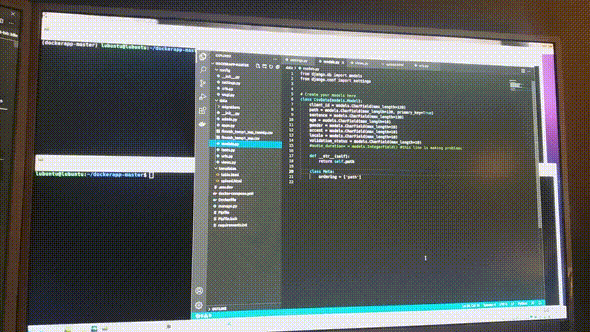Reason for preparig notebook above was requirement to present proof of concept pipeline where particular tasks typical for pandas were required and filtered and processed output should be stored in Postgres
To do dockerising constelation of pandas Django and Postgres. Django is a high-level Python web framework that encourages rapid development and clean, pragmatic design. Built to take care of much of the hassle of web development, so you can focus on writing your app without needing to reinvent the wheel. Proceeding presented by Davide Provasoli was used. He presented all the details in the article. Additionally very informative is also the post prepared by Michael Herman Only word about Django: Get started with Django Meet Django
There was need to do couple of settings in local lubuntu machine.
All the things one need to take care about when installing Docker on Ubuntu machines are under this address: (https://www.digitalocean.com/community/tutorials/how-to-install-and-use-docker-on-ubuntu-18-04).
Next step was installing docker-compose latest version. Handy way of doing that is to check latest version with
# curl + grep
VERSION=$(curl --silent https://api.github.com/repos/docker/compose/releases/latest | grep -Po '"tag_name": "\K.*\d')
and using then CURL
DESTINATION=/usr/local/bin/docker-compose
sudo curl -L https://github.com/docker/compose/releases/download/${VERSION}/docker-compose-$(uname -s)-$(uname -m) -o $DESTINATION
sudo chmod 755 $DESTINATION
There are plenty of places where mistakes are causig that jango server is not up and running. Still I dont know why. Last column with audio duration seconds integer was causing nasty error.
# Create your models here.
class CsvData(models.Model):
client_id = models.CharField(max_length=130)
path = models.CharField(max_length=130, primary_key=True)
sentence = models.CharField(max_length=130)
age = models.CharField(max_length=10)
gender = models.CharField(max_length=10)
accent = models.CharField(max_length=10)
locale = models.CharField(max_length=10)
validation_status = models.CharField(max_length=10)
#audio_duration= = models.IntegerField() #this line is making problems
You need to be careful to which column you assign primery key as first time I diddnt check and client_id was used which crashed export to postgress because there are plenty of records where only path, mp3 fileis unique. to make quicker whole debuging(DEBUG=True in settings.py) VSCode was used as it has also docker extension. Effect is good though there are a lot places for improvement
If you have docker and docker-compose installed as mkvirtualenv tool next step is to create structure of projects etc. One of the easiest way is to use tool which will create ready to use structure. Tool is provided by https://github.com/cookiecutter/cookiecutter-django
Afer preapring new environment and activating, lets call it sound_pipe
mkvirtualenv sound_pipe
lets generate structure of our project answering questions on the way:
cookiecutter gh:cookiecutter/cookiecutter-django
like
project_name [My Awesome Project]: sound_pipe
project_slug [sound_pipe]:
description [Behold My Awesome Project!]: sound_pipe
author_name [Daniel Roy Greenfeld]: John.Doe
domain_name [example.com]:
email [john.doe@example.com]:
version [0.1.0]:
Select open_source_license:
1 - MIT
2 - BSD
3 - GPLv3
4 - Apache Software License 2.0
5 - Not open source
Choose from 1, 2, 3, 4, 5 [1]:
timezone [UTC]:
windows [n]:
use_pycharm [n]:
use_docker [n]: yes
Select postgresql_version:
1 - 14.1
2 - 13.5
3 - 12.9
4 - 11.14
5 - 10.19
Choose from 1, 2, 3, 4, 5 [1]:
Select js_task_runner:
1 - None
2 - Gulp
Choose from 1, 2 [1]:
Select cloud_provider:
1 - AWS
2 - GCP
3 - None
Choose from 1, 2, 3 [1]:
Select mail_service:
1 - Mailgun
2 - Amazon SES
3 - Mailjet
4 - Mandrill
5 - Postmark
6 - Sendgrid
7 - SendinBlue
8 - SparkPost
9 - Other SMTP
Choose from 1, 2, 3, 4, 5, 6, 7, 8, 9 [1]:
use_async [n]:
use_drf [n]:
custom_bootstrap_compilation [n]:
use_compressor [n]:
use_celery [n]:
use_mailhog [n]:
use_sentry [n]:
use_whitenoise [n]:
use_heroku [n]:
Select ci_tool:
1 - None
2 - Travis
3 - Gitlab
4 - Github
Choose from 1, 2, 3, 4 [1]:
keep_local_envs_in_vcs [y]:
debug [n]:
[SUCCESS]: Project initialized, keep up the good work!
I need docker so instead of default n yes was given There are a lot usefull options to choose and the tool take care about generating appropiate setup Structure was created so you could check and build locally initial image( based on local.yml) to check if everything is working
docker-compose -f local.yml build
I need some extra service pandas and numpy for manipulation of the input data To reuse 3.9-slim-bullseye I took setup like below presented by:
https://adamtheautomator.com/python-data-science-libraries/
ARG PYTHON_VERSION=3.9-slim-bullseye
FROM python:${PYTHON_VERSION} as python
LABEL maintainer="SL"
LABEL version="0.1"
LABEL description = "pandas part image"
WORKDIR /data
RUN pip install nbterm numpy matplotlib seaborn pandas
In the local.yml service pandas was added
pandas:
stdin_open: true
tty: true
build:
context: .
dockerfile: ./compose/local/pandas/Dockerfile
image: sound_pipe_loc_postgres
container_name: sound_pipe_pandas_min
volumes:
- ./pandas_data:/data:Z /
in the compose/local/pandas/start change was made to
```
!/bin/bash
```
Created by: [lencz.sla@gmail.com]
